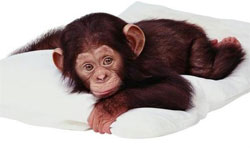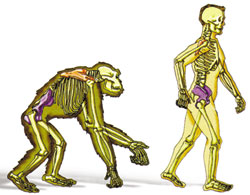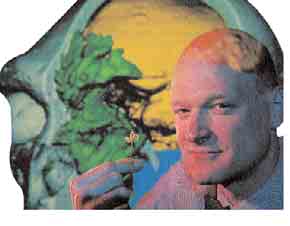 |
Ape's Hands and Feet The entire skeletal structure of apes is designed according to the quadripedal stride. Their arms are long and their skeleton is bent forward. Moreover, their hands and feet are curved to enable them to climb trees. |
 |
COMPUTER SIMULATIONS Evolutionists state that the so-called ancestors of man had a "half-bent, half-erect" posture. Computer simulation studies by Robin Crompton demonstrated that such a form of movement is not possible. A living thing must walk either fully upright or fully bent to make the maximum use of energy. |
This claim is not true. Firstly, the fossil record shows that no life form ever had a way of movement in between the human and the ape stride. Detailed examinations of the fossil record prove that creatures of the Australopithecus and Homo habilis classes walked on all fours and by leaning forward, while human races such as Homo erectus and Neanderthal man walked upright just like us. This means that the bipedal upright stride emerged with humans for the first time and all of a sudden.
Besides, anatomical research conducted in recent years establishes that the gradual evolution of the ape stride into the human stride is impossible. In 1996, the British anatomist Robin Crompton, who conducted research into the bipedal stride of humans, concluded that a motion in between the ape stride and the human stride is not possible. Crompton showed that a living thing can either walk upright or on all fours. A type of in-between stride would be quite ineffective.60
The immense gap between man and ape is not limited solely to bipedalism. Many other issues still remain unexplained such as brain capacity, the ability to talk, and so on. Elaine Morgan, an evolutionist paleoanthropologist, makes the following confession in relation to this issue:
IMAGINARY CREATURES The "half bent" creatures pictured by evolutionists are actually nothing but figments of the imagination. Scientific findings demonstrate that no creatures having a stride in between that of the ape and man ever existed in history. |  |
Four of the most outstanding mysteries about humans are:
The orthodox answers to these questions are:
The list of questions could be considerably lengthened without affecting the monotony of the answers.61
In short, "the evolution of man" is nothing but an unsubstantiated tale. Man is created by God already equipped with all the abilities and features he possesses.
 Fred Spoor Fred Spoor | INNER EAR ANALYSIS RESULTS In the human inner ear, and that of other creatures with complicated structures, there is an organ called the "cochlea," which works out the position of the body relative to the ground. The working of this organ is the same as the implement called a "gyroscope" which maintains the balance of an aeroplane. In order to find out whether the living creatures which were portrayed as man's ancestors walked upright on two legs or not, Spoor carried out studies on this organ, the cochlea. The result he arrived at was that some life forms presented as the ancestor of man had a bent posture just like modern apes and some had an upright posture just like modern humans. This result totally disproves the theory that bipedalism gradually evolved from quadripedalism. |
62) Ruth Henke, "Aufrecht aus den Baumen", Focus, Band 39, 1996, S. 178
63) Elaine Morgan, The Scars of Evolution, New York: Oxford University Press, 1994, S. 5